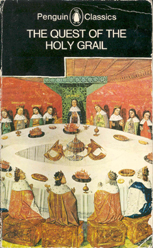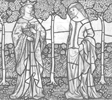Arthurian Legends
Everyone's heard of King Arthur and the Knights of the Round Table, the endless subject of novelizations such as White's The Once And Future King and Munn's Merlin series, not to mention Twain's A Connecticut Yankee In King Arthur's Court, Marion Zimmer Bradley's The Mists Of Avalon, and many others - did I mention I'm a Monty Python fan?
Debates over the existence and identity of a historical king or war-leader of this name, perhaps a 5th or 6th century Welshman, are equally endless.
What's clear is that Arthurian legends, which stem from Welsh traditions carried through the Dark Ages, exploded into popularity across Europe in the 12th century with the dissemination of Geoffrey of Monmouth's 1138 Historia Regnum Brittaniae.
By the end of the same century, the Frenchman Chrétien de Troyes had created a poem that fused older Christian mythology concerning the Holy Grail with Arthurian legends, kicking of a long series of quest stories written throughout Europe.
Among the most influential of these were the Vulgate Cycle a.k.a. Lancelot-Grail, a series of medieval French volumes apparently written by different hands but all following a carefully laid-out sequence.
I've reviewed the second to last of these (see below); other volumes have more to say about the origins of the Grail, Merlin, Lancelot and Guinevere, and the death of Arthur.
It was upon Vulgate Cycle that Sir Thomas Malory based his famous, much more secular Le Morte d'Arthur (published 1485), which I've also got in a 1970 Penguin edition using modern spelling, and will review sometime.
I also have a translation of the Mabinogion, a late medieval compilation of the key Welsh myths that includes a version of the Perceval story (various parts of the Mabinogion have also been novelized by many authors, including Walton).
|
 The Quest Of The Holy Grail (c. 1225) The Quest Of The Holy Grail (c. 1225)
The honest to goodness first full-blown version in French of the Arthurian romance that fits into the Lancelot/Holy Grail cycle (including the Mort Artu = Death Of Arthur), written by an anonymous author in about 1225 and translated by P. M. Matarasso in 1969.
As such, it's a primary source for all of the high fantasy that came later - if Morris and Tolkien didn't read it, well, they must have been indirectly influenced by it.
Unfortunately, the book is basically Christian propaganda.
Although the main characters and some of the many bizarre events stem from what must have been far more entertaining Celtic mythology, here everything is just an excuse for lecturing.
The formula is simple and repetitive: the four main knights on the quest, the morally flawed Lancelot, his infallibly virtuous bastard son Galahad, Perceval, and Bors, wander through a vaguely sketched fantasy landscape having random, mostly violent encounters, often with the devil in various disguises; other, nameless knights; or each other.
After each incident, the knight runs into a hermit, monk, or other holy man, and suffers through a long discourse on the allegorical meaning of what has just happened.
There's so much poorly-founded guilt-tripping in all of this stuff that it's almost unbearable.
So the book is full of fantastic visions and fascinating from a scholarly point of view, but, well, not a lot of fun.
(JA)
|

|
|
|

